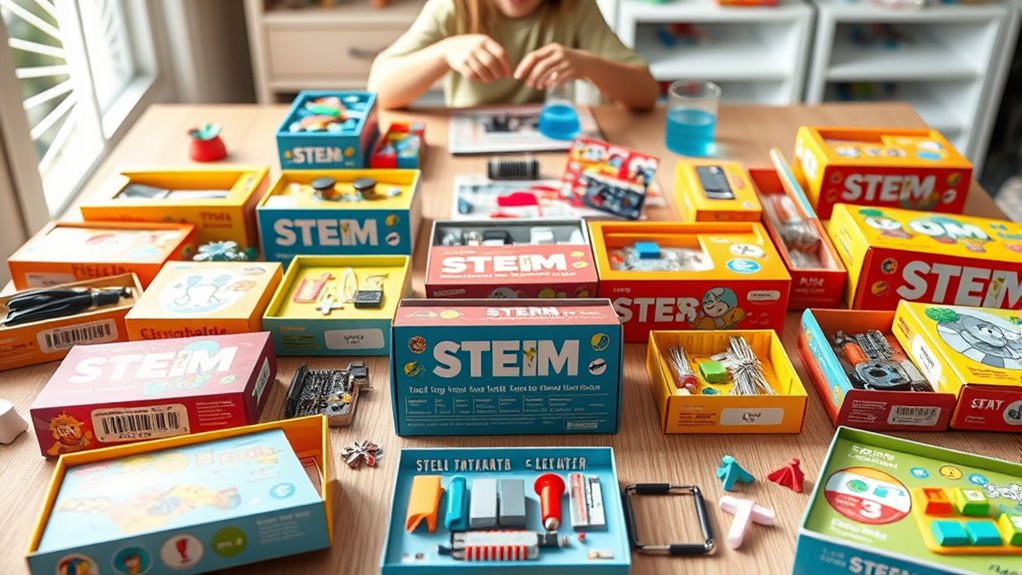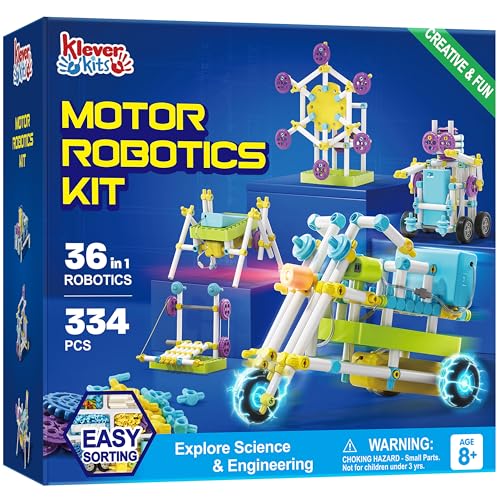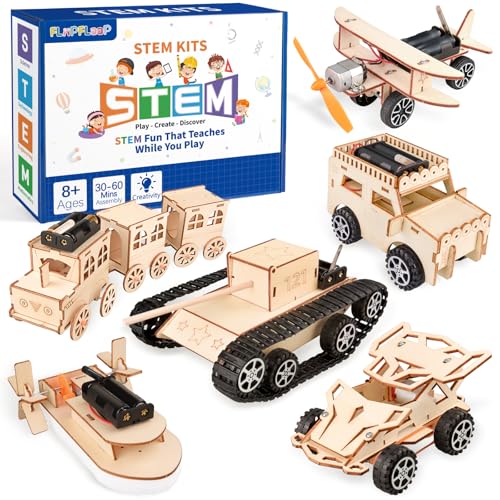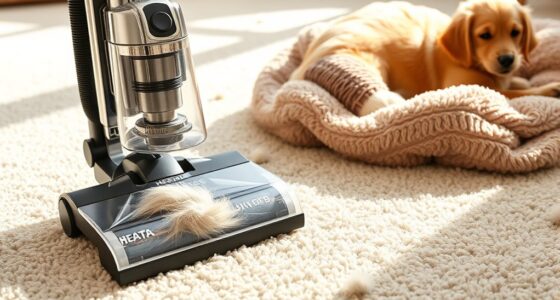I’ve discovered 15 amazing educational STEM kits for kids that turn learning into an exciting adventure! From the Snap Circuits Jr. SC-100, which dives into electronics, to the hands-on experiments of the UNGLINGA kits, each offers unique challenges that spark curiosity. Whether it’s building solar robots or exploring science through fun experiments, these kits cater to various age groups. If you’re curious about which kits will best suit your child’s interests, check out my recommendations!
Key Takeaways
- Diverse Focus Areas: Look for kits that cover electronics, science experiments, robotics, and eco-friendly projects to engage various interests and learning styles.
- Age Appropriateness: Choose kits that match the child’s age and developmental level for optimal engagement and educational value.
- Hands-On Learning: Select kits that encourage experimentation and critical thinking, fostering practical understanding of STEM concepts through interactive activities.
- Safety Standards: Ensure kits comply with safety regulations, using non-toxic materials to guarantee a secure learning environment for kids.
- Positive Customer Feedback: Consider products with high ratings and reviews, reflecting strong educational value and user satisfaction in engaging learning experiences.
Snap Circuits Jr. SC-100 Electronics Exploration Kit for Kids 8
If you’re looking for an engaging way to introduce your 8-year-old to the world of electronics, the Snap Circuits Jr. SC-100 Electronics Exploration Kit is a fantastic choice. It features over 28 color-coded components that snap together effortlessly, allowing my child to create over 100 fun projects. From light switches to voice-controlled lamps, each project builds confidence and sparks creativity. The clear instructions make it easy for them to follow along. Plus, it’s safe and requires no special tools. This award-winning kit has kept my little one engaged for hours, making learning about STEM concepts both fun and memorable!
Best For: Snap Circuits Jr. SC-100 is best for children aged 8 and above who are interested in exploring electronics and STEM concepts through hands-on learning.
Pros:
- Engaging and fun way to learn about electronics with over 100 projects.
- Safe and easy assembly with color-coded components that require no tools.
- Award-winning kit that promotes creativity, independence, and critical thinking.
Cons:
- Requires 2 AA batteries which are not included in the kit.
- Limited to basic and intermediate projects; advanced users may outgrow it quickly.
- Some components may be small and could pose a choking hazard for very young children.
Sillbird 12-in-1 Solar Robot Building Kit for Kids
The Sillbird 12-in-1 Solar Robot Building Kit stands out as an ideal choice for kids aged 8-13, offering them a hands-on approach to learning about science and renewable energy. With 190 parts, kids can build 12 different models, from robots to cars, catering to various skill levels. I love how it encourages problem-solving and creativity while they explore renewable energy concepts. Plus, the large solar panel means they can play outdoors with sunlight or indoors with artificial light. The clear instructions make it easy for kids to build independently or with family, turning learning into a fun, engaging experience.
Best For: The Sillbird 12-in-1 Solar Robot Building Kit is best for children aged 8-13 who are interested in science, engineering, and renewable energy.
Pros:
- Encourages hands-on learning and problem-solving skills through engaging DIY projects.
- Includes a large solar panel, enabling play with renewable energy both outdoors and indoors.
- Clear step-by-step instructions promote independent building and family collaboration.
Cons:
- Requires access to sunlight or artificial light to function, which may limit play in certain environments.
- Some models may be challenging for beginners, potentially leading to frustration.
- The number of parts (190) might be overwhelming for younger or less experienced builders.
Klever Kits 36-in-1 Motor Robotic Kits for Kids
Designed for kids aged 8 to 13, the Klever Kits 36-in-1 Motor Robotic Kit stands out as an engaging educational tool for young aspiring engineers and scientists. With 36 models to build, including 14 motorized robots, this kit sparks creativity and problem-solving skills. The parts tray and full-color instructions simplify organization and assembly, while video tutorials enhance the experience. Although some users report challenges with parts and battery packs, the overall feedback is positive, rating it at 4.8 stars. It’s perfect for solo play or family bonding, promoting screen-free fun while introducing essential STEM concepts.
Best For: Children aged 8 to 13 who are interested in hands-on learning and engaging with robotics and engineering concepts.
Pros:
- Encourages creativity, critical thinking, and problem-solving skills through building various robot models.
- High-quality parts with clear instructions and video tutorials make assembly easier and more enjoyable.
- Suitable for solo or family play, promoting teamwork and screen-free fun.
Cons:
- Some users report challenges with part color discrepancies in instructions, leading to assembly confusion.
- Difficulties with battery pack assembly and motor orientation can frustrate younger or less experienced builders.
- Limited exploration interest after completing a model may lead to a decreased engagement in further building.
Poraxy 4 in 1 STEM Kits for Kids Age 8-10
Looking for a fantastic educational gift for kids aged 8-10? The Poraxy 4-in-1 STEM Kits are perfect! These kits include engaging projects like 3D puzzles, mini ferris wheels, and fiber optic lamps that stimulate creativity and imagination. Assembling these models not only enhances hand-eye coordination but also introduces kids to basic engineering concepts. Made from high-quality laser-cut wood, they’re easy to build and personalize. Plus, the finished projects make stunning displays in any room. With a mix of fun and education, these kits truly make learning engaging for children while fostering their curiosity in science and technology!
Best For: Children aged 8-10 who enjoy hands-on learning and exploring STEM concepts through creative projects.
Pros:
- Encourages creativity and imagination through engaging projects like 3D puzzles and mini ferris wheels.
- Enhances hand-eye coordination and basic engineering skills as kids assemble and personalize their models.
- High-quality materials ensure easy assembly and attractive finished displays that enhance room decor.
Cons:
- Some children may require adult supervision or assistance during assembly, especially with electrical components.
- The complexity of certain projects might be challenging for younger kids within the age range.
- Personalization may require additional materials like paint, which may not be included in the kit.
National Geographic STEM Science Kit for Kids
For kids aged 8 and up, the National Geographic STEM Science Kit is a fantastic choice to spark curiosity and foster a love for Earth sciences. With over 15 exciting experiments like dueling water tornadoes and erupting volcanoes, this kit keeps young minds engaged. I love how it encourages critical thinking while explaining concepts like crystal formation and geology through a detailed learning guide. The quality is impressive, and it’s safe for kids, which is a huge plus. Plus, it’s perfect for group activities. Overall, it’s a fun, educational gift that provides hours of entertainment and learning for kids and adults alike.
Best For: The National Geographic STEM Science Kit is best for children aged 8 and up who are eager to explore Earth sciences through hands-on experiments.
Pros:
- Engaging and educational experiments that promote critical thinking and curiosity.
- High-quality materials ensure durability and safety for young users.
- Ideal for group activities, encouraging collaboration and shared learning experiences.
Cons:
- Some users reported minor issues, such as missing gemstones or stiff magnetic putty.
- Not suitable for children under 8 years old, limiting accessibility for younger kids.
- Requires adult supervision for certain experiments, which may not be convenient for all families.
Creativity for Kids Grow N Glow Terrarium Kit
The Creativity for Kids Grow N Glow Terrarium Kit stands out as an exceptional choice for children aged 6-8 who are enthusiastic to explore the wonders of nature and science. This hands-on kit allows kids to create a mini ecosystem in a mason jar, using real seeds and glow-in-the-dark accents. As they plant and observe their creations, they learn about botany and ecology while developing fine motor skills and creativity. With two planting cycles, the fun continues! I love how it encourages kids to engage with nature, making it a perfect gift for budding scientists and artists alike.
Best For: Children aged 6-8 who are curious about nature and science, looking for a fun and educational hands-on activity.
Pros:
- Encourages exploration of botany and ecology through hands-on experience.
- Supports multiple planting cycles, allowing for repeated learning and engagement.
- Promotes fine motor skills, creativity, and scientific observation in a screen-free environment.
Cons:
- Some users report minor soil odor issues during the planting process.
- Growth may be slower than expected, leading to potential disappointment in plant development.
- Assembly may require adult supervision for younger children to ensure safety and proper setup.
60+ Science Experiment Kit for Kids Ages 5-8
Designed specifically for kids ages 5-8, this Science Experiment Kit sparks curiosity and encourages hands-on exploration of scientific concepts. With over 60 exciting experiments like volcanic eruptions and lava lamps, it makes learning fun! The kit includes all necessary materials, safety goggles, and easy-to-follow guides, allowing kids to immerse themselves in science with minimal supervision. I’ve seen firsthand how it boosts critical thinking and problem-solving skills while keeping young minds engaged. Rated 4.6 out of 5 stars, it’s a fantastic gift for budding scientists. Whether for home or school, this kit is sure to inspire endless scientific adventures!
Best For: This science experiment kit is best for children aged 5-8 who are eager to explore scientific concepts through fun, hands-on activities.
Pros:
- Engages children with over 60 exciting experiments that promote curiosity and scientific thinking.
- Easy-to-follow guides and all necessary materials included, allowing for independent learning with minimal supervision.
- Highly rated for its educational value and ability to keep kids entertained while minimizing mess.
Cons:
- Some experiments may require adult supervision for safety or guidance despite being designed for independent use.
- Limited to the experiments included in the kit, which may not cover all scientific interests.
- Depending on the child’s interests, some may find certain experiments more appealing than others, leading to varied engagement levels.
Learning Resources STEM Explorers Pixel Art Challenge
Looking for a hands-on, engaging way to spark your child’s interest in STEM? The Learning Resources STEM Explorers Pixel Art Challenge does just that! With 10 double-sided challenge cards, kids tackle varying difficulties while enhancing critical thinking and problem-solving skills. As they create vibrant designs with 98 durable foam pieces, they also boost fine motor skills and hand-eye coordination. Suitable for ages 5 and up, this screen-free kit encourages creativity and educational play, making it perfect for classrooms or home. It’s an exciting introduction to art, engineering, and math, fostering a lifelong love for STEM learning.
Best For: The Learning Resources STEM Explorers Pixel Art Challenge is best for children ages 5 and up who are interested in engaging, hands-on STEM activities that promote creativity and problem-solving skills.
Pros:
- Encourages critical thinking and spatial reasoning through varied difficulty levels on challenge cards.
- Enhances fine motor skills and hand-eye coordination with durable foam pieces that are easy to manipulate.
- Provides a versatile educational tool suitable for classrooms, homeschooling, or independent play, maintaining engagement across different skill levels.
Cons:
- Limited to pixel art challenges, which may not appeal to children who prefer other forms of creative expression.
- Requires adult supervision to ensure safe play for younger children, which may limit independent usage.
- Some pieces may be small and pose a choking hazard for very young children if not monitored.
Dan&Darci Light-Up Terrarium Kit for Kids – STEM Science Kit
If you’re searching for an engaging and educational activity for kids aged 6 to 12, the Dan&Darci Light-Up Terrarium Kit is an excellent choice. This STEM kit allows kids to create their own miniature garden inside a jar, complete with a magical light-up lid. It includes everything needed—soil, seeds, decorative miniatures, and more—encouraging hands-on learning and creativity. Watching plants grow fosters patience and responsibility, while the glowing terrarium adds a fun twist at night. Despite minor issues like seed germination, the overall experience is enjoyable, making it a fantastic gift for budding scientists and nature lovers alike!
Best For: Children aged 6-12 who are interested in nature, science, and creative activities.
Pros:
- Engaging hands-on activity that promotes creativity and learning about plant growth.
- Includes all necessary materials and clear instructions for easy assembly and decoration.
- The light-up feature adds a magical element, making the terrarium visually appealing at night.
Cons:
- Some users report issues with seed germination and minimal plant growth.
- The LED light requires frequent charging, which may be inconvenient for nightly use.
- Occasional missing parts, like the spray bottle, have been noted in customer reviews.
Doctor Jupiter My First Science Kit for Kids
For kids aged 4 to 8, the Doctor Jupiter My First Science Kit is a fantastic introduction to the world of STEM. With over 100 experiments like Water Fireworks and Walking Water, it sparks curiosity and critical thinking. The well-illustrated instructions make it easy for both kids and parents to follow along, ensuring a fun learning experience. Safety is a priority, featuring high-quality equipment that meets stringent standards. Many parents rave about how their children become excited scientists, often asking to do multiple activities in one session. It’s a perfect gift that promotes hands-on learning and keeps kids engaged without screens.
Best For: Children aged 4 to 8 who are curious about science and enjoy hands-on learning experiences.
Pros:
- Engages children with over 100 fun and educational experiments that promote STEM learning.
- Clear, well-illustrated instructions make it easy for both kids and parents to conduct experiments together.
- High safety standards and quality equipment ensure a safe learning environment for young scientists.
Cons:
- Some users feel the contents may be too basic for the price of $37, questioning overall value.
- Minor packaging issues reported, such as difficulty in removing larger bottles from storage.
- Requires adult supervision for younger children, which may not be ideal for all parents.
UNGLINGA 50+ Science Lab Experiments Kit for Kids
The UNGLINGA 50+ Science Lab Experiments Kit is perfect for curious kids aged 8 and up who want to plunge into the exciting world of science. With over 50 engaging experiments, kids can create erupting volcanoes, rainbow rain, and even grow gemstones! The detailed learning guide makes it easy to understand the science behind each activity. I love how it encourages critical thinking and problem-solving while making learning fun. Plus, it’s a fantastic way for kids to bond with family and friends. With a high customer rating, it’s a must-have gift for any young science enthusiast ready for hands-on exploration!
Best For: The UNGLINGA 50+ Science Lab Experiments Kit is best for curious kids aged 8 and up who enjoy hands-on learning and exploring scientific concepts.
Pros:
- Encourages critical thinking and problem-solving skills through engaging experiments.
- Includes a detailed learning guide that explains the science behind each activity.
- Provides hours of fun and educational exploration, perfect for sharing with family and friends.
Cons:
- Requires adult supervision, especially for younger children, to ensure safety during experiments.
- Some materials may be common household items that could limit the uniqueness of experiments.
- The kit may not be suitable for very young children due to small parts and complexity of some activities.
6-in-1 STEM Kits for Kids Age 8-12
Looking for an engaging way to spark your child’s interest in science and engineering? The 6-in-1 STEM Kit for kids ages 8-12 is a fantastic choice! With six models to build, including a hydraulic excavator and a microscope, it offers hands-on learning that reduces screen time. The kit’s durable wooden components promote creativity and problem-solving while encouraging teamwork and bonding. Plus, it’s packaged beautifully, making it a perfect gift for any occasion. Rated highly by users, it provides endless fun and educational experiences, ensuring your child is not just learning, but loving the process!
Best For: Children aged 8-12 who are curious about science and engineering and enjoy hands-on, interactive learning experiences.
Pros:
- Promotes STEM learning through engaging models that teach physics concepts and problem-solving skills.
- Encourages teamwork and bonding between parents and children during assembly and experimentation.
- High customer satisfaction with a 4.6 out of 5-star rating, indicating quality and educational value.
Cons:
- Assembly instructions could be clearer, leading to potential confusion for some users.
- Requires AA batteries not included in the kit, which may be an inconvenience.
- Some models may need adult assistance, which could limit independence in younger children.
UNGLINGA 70 Lab Experiments Science Kits for Kids
If you’re seeking a hands-on way to ignite your child’s curiosity in science, the UNGLINGA 70 Lab Experiments Science Kits for Kids stands out as an excellent choice. This kit offers 70 engaging experiments, like erupting volcanoes and balloon rockets, allowing kids to explore scientific principles while having fun. The easy-to-follow manual, complete with illustrations, helps them grasp concepts and understand chemical reactions. Plus, it encourages teamwork as children can share their discoveries with family and friends. With a focus on safety and quality, this kit assures a positive learning experience that fosters a lasting interest in STEM fields.
Best For: Children aged 8 and up who are interested in exploring science through hands-on experiments and activities.
Pros:
- Engages children with 70 diverse and fun experiments that foster curiosity and learning.
- Easy-to-follow manual with clear illustrations enhances understanding of scientific concepts.
- Promotes teamwork and social interaction as kids can share their experiments with family and friends.
Cons:
- Some experiments may require additional household items not included in the kit.
- The complexity of certain experiments may not be suitable for younger children without adult supervision.
- Limited depth on advanced scientific concepts may leave older or more experienced young scientists wanting more.
UNGLINGA 150 Experiments Science Kits for Kids
For kids excited to plunge into the wonders of science, the UNGLINGA 150 Experiments Science Kit is the perfect choice. This kit offers 150 engaging DIY experiments covering earth science, chemistry, and physics, sparking curiosity and hands-on learning. I love the well-illustrated manual that makes following the experiments easy and fun. With high-quality lab tools and safety goggles, kids can explore safely, often using common household items. It’s a fantastic gift for any occasion, turning playtime into quality science time. I can’t wait to see my child develop critical thinking skills while having a blast with these experiments!
Best For: Kids aged 6 and up who are curious about science and enjoy hands-on learning through experiments.
Pros:
- Engages children with 150 diverse experiments across various scientific topics, fostering curiosity and exploration.
- Includes a well-illustrated manual that simplifies complex concepts, making it easy for kids to follow along.
- Provides high-quality tools and safety equipment, ensuring a safe and authentic lab experience at home.
Cons:
- Some experiments may require additional household items that not all families may have readily available.
- The complexity of certain experiments might not be suitable for very young children without adult supervision.
- The kit may contain small parts that could pose a choking hazard for younger kids.
Sntieecr Electric Circuit Motor Kit for Kids STEM Engineering Project
The Sntieecr Electric Circuit Motor Kit stands out as an ideal choice for kids aged 8 and up, who are enthusiastic to plunge into the fascinating world of science and engineering. This kit comes loaded with components like motors, bulbs, and crocodile clip leads, making it perfect for hands-on learning about circuits. I love how it encourages creativity and critical thinking through experimentation. While some users note minor issues, the overall quality and educational value are impressive. Just remember to supervise your kids and follow safety guidelines, ensuring a fun and safe exploration of electrical principles!
Best For: The Sntieecr Electric Circuit Motor Kit is best for kids aged 8 and above who are eager to explore and learn about science, electronics, and engineering through hands-on activities.
Pros:
- Encourages creativity and critical thinking through experimentation with electrical circuits.
- Comprehensive components included for easy assembly and engaging learning experiences.
- Positive feedback for educational value and durability of parts.
Cons:
- Some users reported minor issues with non-functional bulbs or small instruction pamphlets.
- Concerns about overheating battery packs and weak motors for certain applications.
- Inconsistencies between product images and received items may lead to customer dissatisfaction.
Factors to Consider When Choosing Educational STEM Kits for Kids

When I’m choosing STEM kits for kids, I always consider a few key factors. It’s important to think about age appropriateness, educational value, and safety standards, along with how complex the assembly is and the variety of projects included. Each of these aspects can really impact how much kids enjoy and learn from the experience.
Age Appropriateness
Choosing the right educational STEM kit for kids involves careful consideration of age appropriateness. First, I always check the label for the recommended age range, like 5+, 8-12, or 13+, to make certain it matches my child’s developmental level. Younger kids thrive on simpler projects, so I look for kits with easy, step-by-step instructions. I also keep an eye out for small parts that could pose choking hazards, especially for children under 3 or 5 years old. It’s vital to choose a kit that aligns with my child’s cognitive skills and problem-solving abilities to keep them engaged without feeling overwhelmed. Finally, I verify that the content is age-appropriate, whether it’s basic circuitry for younger kids or advanced robotics for teens.
Educational Value
Understanding the educational value of STEM kits is essential for making the right choice. I look for kits that effectively teach core concepts like circuitry, engineering, biology, or physics through hands-on activities. High-quality kits have clear instructions and guided projects that foster critical thinking and problem-solving skills. I appreciate when they include real, functional components, as this enhances my child’s practical understanding of scientific principles. Age-appropriate design is key; it ensures kids are challenged yet not overwhelmed, supporting their developmental milestones. Finally, I love kits that offer opportunities for progression, allowing children to build on foundational skills and explore more advanced concepts over time. This way, learning remains engaging and fun.
Safety Standards
While exploring educational STEM kits for my child, I can’t overlook the importance of safety standards. I always make sure the kit complies with recognized standards like ASTM F963 or CE to guarantee safe use. Checking that all materials are non-toxic and BPA-free helps prevent health risks during hands-on activities. I also look for kits that include safety gear like goggles or gloves and provide clear adult supervision guidelines. It’s essential to confirm that any small parts or choking hazards are clearly labeled and age-appropriate. Lastly, I review manufacturer safety certifications and customer feedback to verify the product has been tested and approved for safe use by children. Prioritizing safety makes learning fun and worry-free!
Assembly Complexity
When it comes to selecting the right educational STEM kits for kids, assembly complexity plays a crucial role in guaranteeing a positive experience. I’ve found that kits with over 50 pieces can be quite challenging, requiring more time and patience. For younger children or beginners, simpler kits with fewer parts or pre-assembled components work best, as they reduce frustration and foster early success. Look for kits that offer clear, step-by-step instructions and visual guides; these can really help kids assemble independently. On the other hand, if a kit has intricate parts and multiple assembly stages, it’s better suited for older or more experienced children. Evaluating complexity relative to your child’s age and skills ensures an engaging and manageable learning experience.
Variety of Projects
Choosing a STEM kit with a variety of projects can greatly enhance your child’s learning experience. A diverse range of activities keeps kids engaged and encourages broader skill development. These kits cater to different interests within science, technology, engineering, and math, allowing for a personalized learning journey. I love that they often include projects of increasing complexity, helping my child build confidence as they tackle both simple and challenging tasks. Plus, the variety means the kit can be used repeatedly, maximizing its educational value over time. A well-rounded STEM kit fosters curiosity, creativity, and critical thinking by exposing kids to a range of scientific concepts and engineering challenges. It’s all about making learning fun and impactful!
Material Quality
Selecting a high-quality STEM kit is essential to ensuring a safe and enjoyable learning experience for kids. I always look for kits made from durable, non-toxic materials like BPA-free plastics, laser-cut wood, or metal components. These materials not only guarantee safety but also enhance longevity, minimizing breakage and wear during play. When pieces fit securely together—thanks to well-finished and precisely cut components—it reduces frustration for young builders. I also pay attention to certifications or safety standards, like ASTM or CE labels, as they indicate that the materials meet strict guidelines. Investing in high-quality kits means they can withstand multiple uses, maximizing educational value and overall satisfaction for my little learners.
Frequently Asked Questions
Are These Kits Suitable for Children With No Prior STEM Experience?
Absolutely, these kits are perfect for kids with no prior STEM experience! I’ve seen how they provide hands-on activities that break complex concepts down into simple, manageable tasks. My younger sibling jumped right in without any background and loved it! The instructions are clear, and the projects spark curiosity, making learning feel like play. It’s a great way to introduce STEM in a fun and engaging manner that builds confidence in young learners.
What Age Ranges Are These STEM Kits Designed For?
Most STEM kits cater to a variety of age ranges, typically from preschoolers around 4 years old up to teens around 16 years old. I’ve found that many kits specify age recommendations, which helps in selecting the right one. It’s exciting to see how these kits engage kids at different developmental stages, fostering curiosity and creativity. Personally, I love exploring options that challenge my child while being age-appropriate and fun!
How Long Do the Projects Typically Take to Complete?
Most projects in these kits typically take anywhere from 30 minutes to a couple of hours to complete, depending on the complexity. I’ve found that some kids breeze through simpler tasks, while others enjoy taking their time with more intricate builds. It’s great to see them so engaged! I always encourage them to take breaks if they need to, as it helps keep the experience enjoyable and stress-free.
Do These Kits Require Additional Materials or Supplies?
Most kits don’t require additional materials, but I’ve found that having some basic supplies on hand, like scissors or tape, can be helpful. It’s interesting how many projects can spark creativity with just what’s included. I often plunge into the kits thinking I’ll need extra items, only to realize that everything I need is right there. This makes the experience smoother and keeps the focus on learning and exploration.
Are the Kits Safe and Non-Toxic for Children?
Absolutely, the kits I’ve checked are safe and non-toxic for children. I always look for labels that indicate compliance with safety standards, ensuring the materials used are child-friendly. It’s essential to me that my kids can explore and learn without any harmful substances. Plus, many reputable brands emphasize safety in their marketing, so I feel confident when I choose these kits for my little ones’ educational adventures.
Conclusion
In a world where curiosity can lead to endless discoveries, these STEM kits are your child’s gateway to exploration and creativity. Just like young scientists in a lab, they’ll delve into hands-on learning that sparks their imaginations. As you choose the perfect kit, remember that every experiment is a step toward opening their potential. So, gear up for a thrilling journey into science, technology, engineering, and math—who knows, you might just inspire the next great inventor!


























